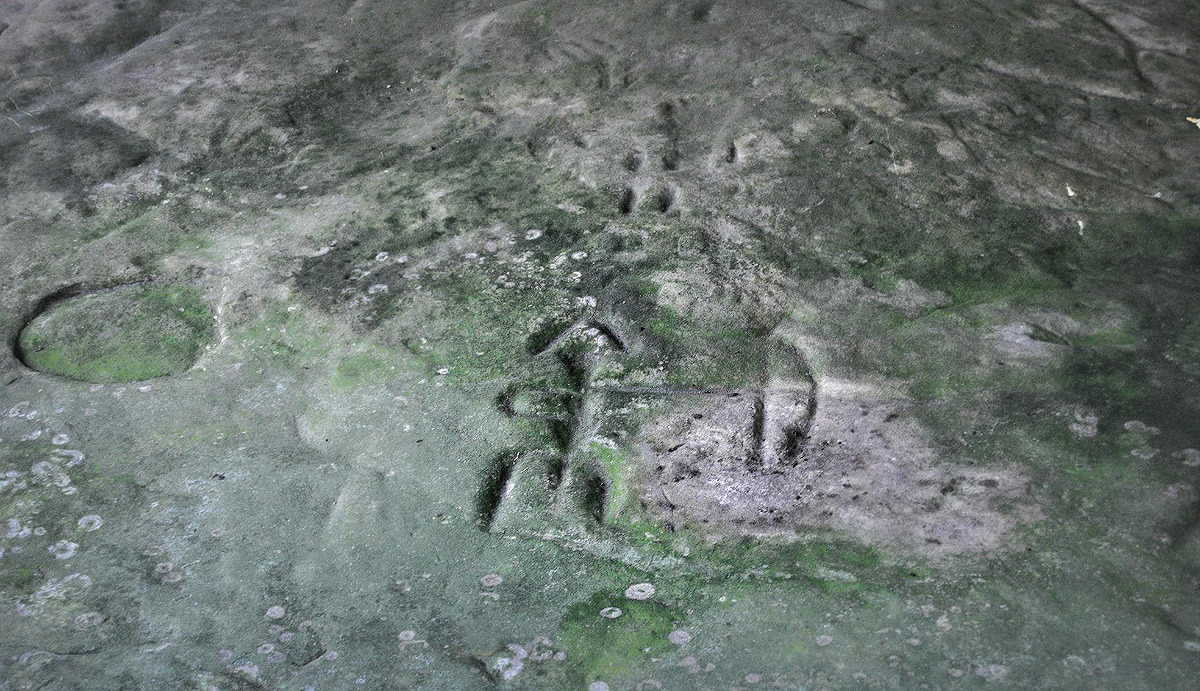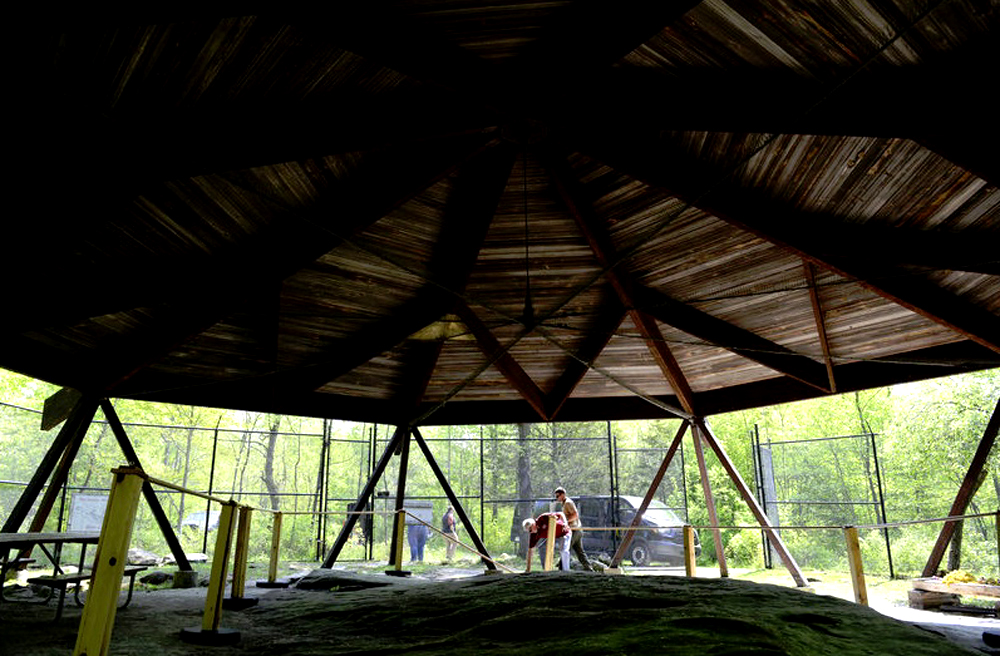


An article by Kathleen Lavey on SouthBendTribune - Petroglyphs in Michigan provide link to Native American past - reports on the prehistoric carvings at Sanilac Petroglyphs State Park.

Stacy Tchorzynski carries out ritual offerings at the low dome of sandstone, adorned with engraved images sacred to Great Lakes Native American tribes: Ebmodaakowet, the archer (above) who shoots knowledge into the future, Migizi Inini, the Eagle Man, who looks to the east - the direction of the new day - and flies over to ensure people are following traditions and teachings, Mishibizhew, the water panther, who protects the waters of the Great Lakes.
According to Tchorzynski, an archaeologist with the state Historic Preservation Office and the Michigan Historical Center, the offering of tobacco, or asemma, is an acknowledgment of the carvings and of all that people take from the earth.
Sacred site #petroglyphs in Michigan provide link to Native American past #Sanilac #RockArt https://t.co/lt38sSvys0 pic.twitter.com/P2UWs1iSGt
— Bradshaw Foundation (@BradshawFND) June 29, 2016
The 240-acre park was created in 1970 to preserve the carvings, which are Michigan's largest known concentration of petroglyphs, or Native American carvings into rocks. Other Great Lakes sites include the Jeffers site in Minnesota and a collection of carvings in Peterborough, Ontario. The protection of the petroglyphs is enabled by the cooperative effort of the state's Department of Natural Resources (DNR), the state Office of Historic Preservation, and members of the Saginaw Chippewa tribe.
It is likely that the petroglyphs, known as ezhibiigaadekasin or "written in stone", were carved 600 to 1,000 years ago, according to William Johnson, who leads the cultural resource management at the Ziibiwing Center, a museum and learning facility operated by the Saginaw Chippewa Tribe in Mount Pleasant.
Petroglyphs are one of many ways previous generations of Anishnabe people left information for the future, states Shannon Martin, director of the Ziibiwing Center. Others include pictographs, or paintings on rocks; birch bark scrolls handed down through generations; and effigy earth mounds, huge mounds in stylized animal or symbol shapes used for burial or storage caches and once common throughout Michigan and the Midwest.
The Sanilac carvings, on an outcrop of sandstone near the banks of the Cass River, were lost to history for some time during the 19th century, overgrown with brush in the river's flood plain and surrounded by farmland. That corresponds with the 19th century period of cultural trauma as white settlers pushed Native Americans into assimilation and onto reservations, sometimes by force.
The carvings lie in the historical territory of the Saginaw Chippewa, but are part of the history and tradition of Michigan's 51 Native American tribes and bands. Anishinabe is how the Chippewa refer to themselves and other native peoples. Various tribes and bands would gather in this region during the summers, to share in harvesting and hunting as well as the sacred carvings.
Archaeologists have studied the site since the 1920s, making plaster casts and taking rubbings of the carvings. Some of those are now in the collection at Cranbrook Institute of Science. In the 1940s, Cranbrook's director Robert Hatt worked with University of Michigan's Museum of Anthropology and the DNR to create a plan to preserve the carvings in the form of a state park. In 1966, the Michigan Archaeological Society bought 80 acres containing the petroglyphs; the additional property was added later. It donated the land to the state with the caveat that the petroglyphs be preserved and available to the public.

The relatively soft sandstone is susceptible to erosion, therefore protection has been provided by a circular, open-air pavilion, whilst in the winter it is wrapped in an insulating material to keep snow and ice off of the rock as much as possible.
As a sacred site, the first official tribal gathering in decades was held in July 2002; camping, a sacred fire burning, teachings and a sweat lodge. In essence, a reconnection to the site - Native Americans see the site as part of a living tradition, and a place to be used. Currently, the Saginaw Chippewa tribe hosts annual spring and fall events, open to the public, at the site to carefully clean and sweep the rock. Discussions between the Chippewa tribe and archaeologists are currently underway regarding re-etching, to ensure the continuation of the teachings, in much the same way as Wandjina paintings in north-western Australia are re-painted.
Visit the American Rock Art Archive:
http://www.bradshawfoundation.com/america/index.php
by Bradshaw Foundation
Friday 09 August 2024
by Bradshaw Foundation
Wednesday 24 July 2024
by Bradshaw Foundation
Thursday 04 July 2024
by Bradshaw Foundation
Monday 01 July 2024
by Bradshaw Foundation
Wednesday 20 March 2024
by Bradshaw Foundation
Tuesday 13 February 2024
by Bradshaw Foundation
Tuesday 13 February 2024
by Bradshaw Foundation
Thursday 01 February 2024
by Bradshaw Foundation
Tuesday 28 November 2023
by Bradshaw Foundation
Thursday 23 November 2023
by Bradshaw Foundation
Monday 20 November 2023
by Bradshaw Foundation
Tuesday 31 October 2023
by Bradshaw Foundation
Thursday 26 October 2023
by Bradshaw Foundation
Wednesday 20 September 2023
by Bradshaw Foundation
Monday 17 July 2023
by Bradshaw Foundation
Sunday 09 July 2023
by Bradshaw Foundation
Friday 09 August 2024
by Bradshaw Foundation
Wednesday 24 July 2024
by Bradshaw Foundation
Thursday 04 July 2024
by Bradshaw Foundation
Monday 01 July 2024
by Bradshaw Foundation
Wednesday 20 March 2024
by Bradshaw Foundation
Tuesday 13 February 2024
by Bradshaw Foundation
Tuesday 13 February 2024
by Bradshaw Foundation
Thursday 01 February 2024
by Bradshaw Foundation
Tuesday 28 November 2023
by Bradshaw Foundation
Thursday 23 November 2023
by Bradshaw Foundation
Monday 20 November 2023
by Bradshaw Foundation
Tuesday 31 October 2023
by Bradshaw Foundation
Thursday 26 October 2023
by Bradshaw Foundation
Wednesday 20 September 2023
by Bradshaw Foundation
Monday 17 July 2023
by Bradshaw Foundation
Sunday 09 July 2023
Friend of the Foundation











